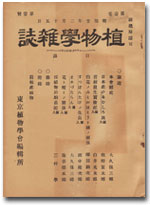All issues

Volume 57, Issue 681-682
Displaying 1-5 of 5 articles from this issue
- |<
- <
- 1
- >
- >|
-
II. The Development of Special Organs of the Gynophores having Root-hair AppearanceSadao Yasuda1943 Volume 57 Issue 681-682 Pages 313-318
Published: 1943
Released on J-STAGE: June 18, 2007
JOURNAL FREE ACCESSIt is an interesting phenomenon that some root-hair-like organs develop on the surface of gynophores as well as on the skin of the young fruit. They are composed generally of a single cell, rarely of several cells. In the former case they look like the root-hairs, while in the latter case their appearance is somewhat like that of beads. The single-cell hairs develop with the elongation of the epidermal cells of the young portion, while the bead-like hairs grow out from the inner layer, breaking through the epidermis, of the older portion.
These two kinds of hairs develop under wet conditions where the fruit can grow. Dry and physiological drought conditions, under which the fruit cannot develop, inhibit the growth of these root-hair-like organs.
In short, it may be said, as far as the author′s experiments have gone, that the fruit can grow only under conditions where the root-hair-like organs can develop.View full abstractDownload PDF (561K) -
FUJI YOSHIMURA1943 Volume 57 Issue 681-682 Pages 319-331
Published: 1943
Released on J-STAGE: June 18, 2007
JOURNAL FREE ACCESSSome Lemnaceae plants were cultured asepticaly. The pathological symptoms which appear when one of the essential elements, N, Ca, Mg, K, P and S, is eliminated, were studied. The abnormal condition became more remarkable in each new culture, and the plant died at last for want of any one of certain essential elements.View full abstractDownload PDF (1293K) -
G. YAMAHA, R. UEDA1943 Volume 57 Issue 681-682 Pages 332-344
Published: 1943
Released on J-STAGE: June 18, 2007
JOURNAL FREE ACCESSDie Wirkung der Ultraschallwellen (WSU) auf die Zellen von Spirogyra sp., der Blätter von Elodea densa und der Staubfadenhaare von Tradescantia reflexa wurde mikroskopisch untersueht. Die Ergebnisse lassen sich folgendermassen zusammenfassen:
1. USW bewirken bei Spirogyra und Tradescantia die Wirbelbewegung des Zytoplasmas; dabei ballen sich das Zytoplasma stellenweise an die Zellmembranen zusammen. Diese Wirkung der USW findet immer reversiblerweise statt.
2. Der Protoplast von Elodea densa dreht sich durch die Wirkung von USW als Ganzes um. Diese Drehung tritt bei den Mittelrippenzellen am leichtesten auf, während sie in den ausgewachsenen Zellen selten vorkommt.
3. Infolge der Wirbelbewegung des Zytoplasmas vermischt sich dasselbe bei Spirogyra mit dem Zellsaft, wobei ein Emulsionssystem entsteht.
Bei der Unterbrechung der USW entmischt dieses Emulsionssystem nach etwa 10 bis 30 Minuten und die Zellen kehren wleder in den normalen Zustand zurück.
4. Die Geschwindigkeit der Protoplasmaströmung wird durch die USW bei Spirogyra wenig beeinflusst; dagegen erhöht sie sich dadurch bei Elodea und Tradescantia oder kommt sie völlig zum Stillstand, wobei das Zytoplasma wahrscheinlich eine Koagulation erfährt.
5. Bei Spirogyra, Elodea und Tradescantia wandern die Zytoplasmakügelchen teilweise in den Zellsaftraum hinein, um sich dort weiter zu drehen. Diese Zytoplasmakügelchen fliessen nach der Unterbrechung der USW mit dem Protoplasmawandbeleg zusamnlen.
6. Durch ziemlich starke USW-Wirkung wird das Protoplasma im Allgemeinen teilweise zerstört oder koaguliert.
7. Bei der Wirkung der USW lassen sich bei Elodea-Blattzellen eine Reihe von Zellzonen in der Querrichtung des Blattes bemerken. Diese Zellzonen unterscheidet sich durch die Wirkung der USW folgendermassen: von den Mittelrippen nach dem Blattrande hin, völlig (fein granulär) zerstörte Zonen, teilweise zerstörte Zonen, Zonen der kontrahierten Zellen und schliesslich verschonte (gesunde) Zonen.
8. Durch die Wirkung von USW erleiden die Chloroplastenbände von Spirogyra Umdrehung, Verwickelung, unregelmässige Anordnung, Kontraktion, Segmentierung und schliesslich Quellung. Nach dem Ausschalten der USW gleicht Chloroplastenumdrehung aus.
Das Ende der geschnittenen Chloroplasten erscheint immer eckig, während sich das Zytoplasma beim Abschneiden abrundet. Aus dieser tatsach lässt sich eine höhere Viskosität der Chloroplasten schliessen.View full abstractDownload PDF (1319K) -
Studien über Thuidiopsis und Thuidium in Nippon (I)Kyuichi Sakurai1943 Volume 57 Issue 681-682 Pages 345-351
Published: 1943
Released on J-STAGE: June 18, 2007
JOURNAL FREE ACCESS -
MASATO TAHARA1943 Volume 57 Issue 681-682 Pages 352-356
Published: 1943
Released on J-STAGE: June 18, 2007
JOURNAL FREE ACCESS1. If the eggs of Coccophora Langsdorfii in the course of the first division after fertilization are centrifuged, different anomalous embryos develop. For example, in the lower or in the upper half of an embryo segmentation does not occur at all.
2. In a case, in which the eggs of Coccophora Langsdorfii were fertilized in a glass vessel many strongly constricted embryos appeared. In a later stage of development of these embryos rhizoids developed not only in the lower extremity, but also in the upper entremity or in the constricted portion of the embryos.
3. If the fertilized eggs of Sargassum tortile in their eight nucleate stage are centrifuged, in the first step of development, the eggs are segmented not in two, but in several cells.View full abstractDownload PDF (1069K)
- |<
- <
- 1
- >
- >|